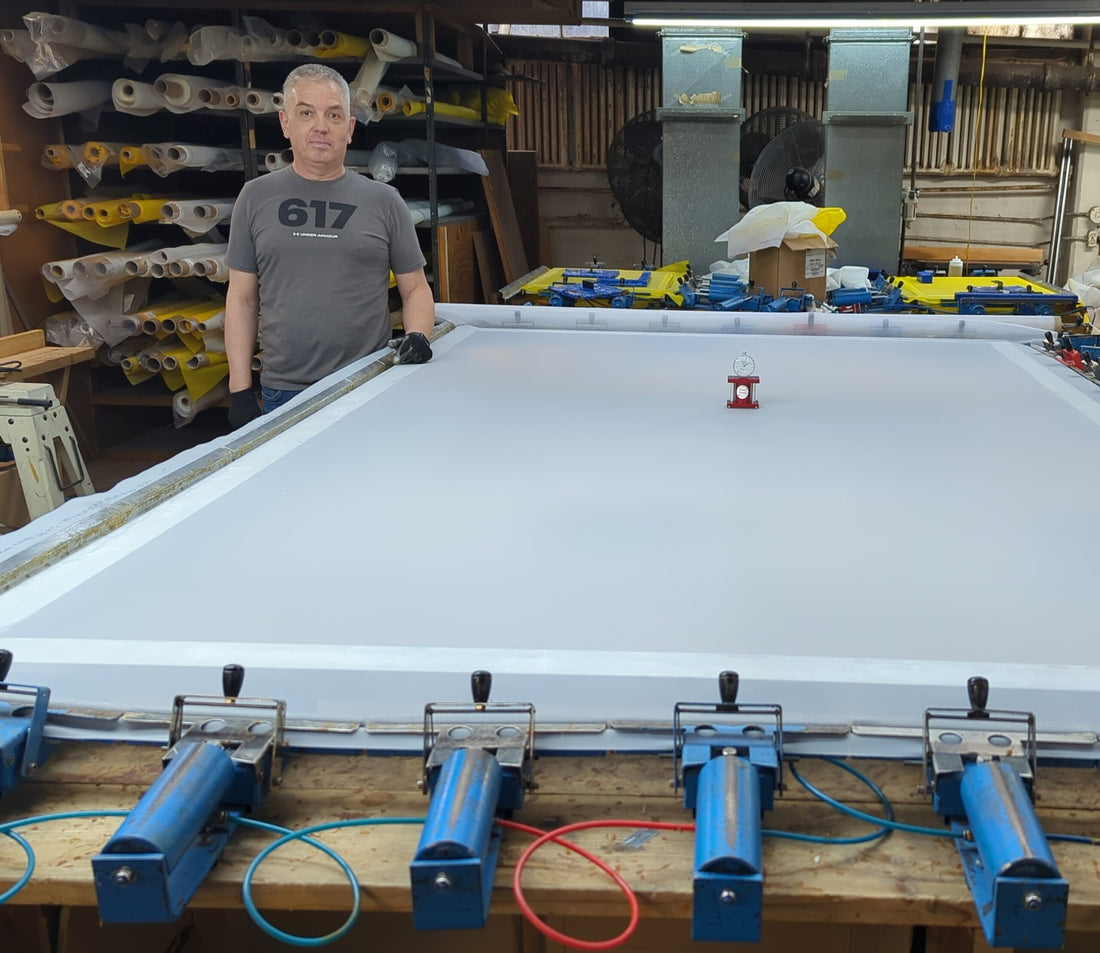
Screen Printing Tension for Quality Prints
Share
When creating quality prints with screen printing, tension is essential. It's something that all screen printers should pay close attention to in order to get the best results. But how do you know what screen tension is and how to properly adjust it? Screen tension refers to the amount of stress applied to the mesh of a screen printing screen by attaching it to a frame and stretching it tight. It's an important part of the screen printing process, as it ensures that the mesh is taut enough to hold the stencil in place and allow for a clear, consistent print. If the mesh is too loose, the ink will not have the proper amount of contact with the substrate, resulting in a poor-quality print. Too much tension can also cause the mesh to deform or break, causing further problems. In this blog post, we'll take a deep dive into the importance of screen tension, how to adjust it correctly, and why it's essential for high-quality prints. We'll look at the types of tension and how to measure them, as well as how to maintain optimum tension as the screen wears and stretches. If you're serious about screen printing and want to deliver professional-looking results, read on to learn more about screen tension.
Introduction
Screen tension is an essential element of creating a high quality print job. It is necessary to ensure that the mesh and stencil material perform optimally, resulting in a perfectly sharp, even print. Achieving this perfect tension requires some time, effort and specialist tools. The process of obtaining accurate screen tension involves various steps such as attaching the frame, stretching the fabric, and securing the edges. By understanding the importance of screen tension, printers can produce quality prints consistently and avoid issues such as broken screens and low-quality prints. This article will discuss why screen tension is essential for quality prints and how to achieve it correctly.
What is Screen Tension?
What is Screen Printing Screen Tension? Screen printing screen tension refers to the amount of tension or tightness in the mesh of the screen. This tension is created by stretching the mesh over a frame, typically made of wood or aluminum. The more tension there is in the mesh, the better the print quality will be. Proper tension ensures that the ink is transferred evenly and accurately onto the substrate, resulting in crisp, clean lines and vibrant colors. Screen tension is typically measured in Newtons per centimeter (N/cm). This is the most accurate way to measure the force applied to the mesh and ensure uniform tension. If the tension is too low, there will be gaps in your print where ink won't be transferred properly. If the tension is too high, then the mesh can stretch and warp, resulting in poor prints. To achieve the right tension levels, you'll need to use a tension meter and a stretching tool. The tension meter is designed to measure the N/cm of tension as you pull the mesh over the frame, while the stretching tool helps to evenly distribute the tension and ensure that all areas of the mesh have the same amount of pressure applied. With the help of these tools, you can ensure that your final prints look crisp and professional.
Why is Screen Tension Essential for Quality Prints?
Screen tension is an essential factor for quality results when printing. Screen tension is the tightness of the mesh fabric stretched on the frame used for printing. This tension determines the accuracy and quality of the prints produced by the printer, making it extremely important to make sure that the tension is at a set level.
High tension produces sharper images with cleaner edges, whereas low tension produces images with less accuracy. When the tension is too low, the threads of the mesh can sag and become slack, resulting in a blurred print. Additionally, the spaces between the threads of the mesh become larger, which affects the resolution of the print. Not only does this result in imperfect printing, but it also puts more pressure on the squeegee when it’s pushed across the screen.
To ensure that the screen tension is at the right level, printers need to use special tools to measure and adjust the tension level. Different types of screen printing require different levels of tension, but in general, an ideal tension level should fall between sixteen newtons and twenty-four newtons. Measuring the tension level and adjusting it as needed is the key to getting a consistent quality of prints.
Without the right screen tension, the quality of prints will suffer and the cost of production will increase. So it’s important to regularly check the tension level of the mesh and make necessary adjustments. Taking proper care of the printing equipment will ensure consistent and quality results. Screen tension is an essential factor for quality prints and should not be neglected.
How to Achieve Proper Screen Tension
How to Achieve Proper Screen Tension Achieving proper screen tension is a crucial step in the screen printing process. Here are the steps to follow to achieve proper screen tension:
- Choose the right mesh count: The mesh count refers to the number of threads per inch in the mesh. A higher mesh count will result in finer detail but requires more tension. The right mesh count depends on the design being printed, the substrate, and the ink being used. Victory Screen Factory offers a variety of Mesh for every purpose you have.
- Stretch the mesh: The mesh should be stretched over the frame tightly and evenly. Use a mesh stretching machine or a manual stretching tool to ensure that the mesh is stretched evenly in all directions. It's important to stretch the mesh gradually to avoid overstretching it, which can lead to uneven tension.
- Measure the tension: Use a tension meter to measure the tension in the mesh. The ideal tension varies depending on the mesh count, but generally, the tension should be between 20 and 30 N/cm. For some printing applications like printing on curved objects you might need lower tension.
- Adjust the tension: If the tension is too low, adjust it by tightening the mesh. If the tension is too high, adjust it by loosening the mesh. Make sure to adjust the tension gradually to avoid overstretching the mesh.
- Glue or staple the mesh to the screen. If you are using aluminum screens we recommend Saati Ultrafix SB3 Plus.
- Maintain your screens well and check tension from time to time. Once the screen is no longer usable remove the mesh, clean the frame and repeat the process.
Conclusion
In conclusion, creating and maintaining a tight screen tension is essential for quality prints. To ensure consistent tension, a good practice is to check the tension of the frame from time to time. Additionally, it is important to use the right kind of mesh for your project to ensure longevity and facilitate efficient printing. With the right tools and knowledge, creating a well-tensioned screen can become a much smoother process. When the screen tension is consistently high, you will be able to enjoy quality prints that you can be proud of. Screen tension is an important factor that determines the success of your projects and should never be overlooked. Pay attention to the techniques and tips described in this article to achieve your desired results and make sure that screen tension is always set correctly.
